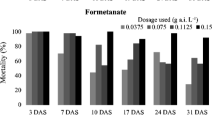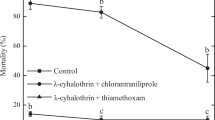Abstract
Sixteen pesticides including two fungicides were evaluated for toxicity to adult Tamarixia radiata (Waterston) (Hymenoptera: Eulophidae), a parasitoid of the Asian citrus psyllid, Diaphorina citri Kuwayama (Hemiptera: Psyllidae). Percentage mortality data were evaluated to generally assess IPM-compatibility of the pesticides with adult parasitoids. The following were found to be least compatible with (most toxic to) adult T. radiata based on the toxicity of direct sprays and potential long residual life on leaves: carbaryl, chlorpyrifos, and fenpropathrin. Although highly toxic to the parasitoid as direct sprays or freshly dried residues, each of the following was more compatible with T. radiata because the toxicity of residues of these pesticides was either low at one to three days after application or relatively non-persistent: abamectin, chenopodium oil, fenpyroximate, and spirotetramat. Depending on environmental conditions, imidacloprid (foliar-applied), phosmet, pyridaben, sulfur and 435 spray oil might also be somewhat more compatible for the same reasons. The pesticides that consistently appeared to be most compatible with T. radiata were aluminum tris, copper hydroxide, diflubenzuron, and kaolin clay (Surround WP).

Similar content being viewed by others
References
Abbott W (1925) A method for computing the effectiveness of an insecticide. J Econ Entomol 18:265–267
Barr NB, Hall DG, Weathersbee AA, Nguyen R, Stansly P, Qureshi JA, Flores D (2009) Comparison of laboratory colonies and field populations of Tamarixia radiata, an ecto-parasitoid of the Asian citrus psyllid, using international transcribed spacer and cytochrome oxidase subunit 1 DNA sequences. J Econ Entomol 102:2325–2332
Bové JM (2006) Huanglongbing: a destructive, newly-emerging, century-old disease of citrus. J Plant Pathol 88:7–37
Chiasson H, Vincent C, Bostanian NJ (2004) Insecticidal properties of a Chenopodium-based botanical. J Econ Entomol 97:1378–1383
Chien CC (1995) The role of parasitoids in the pest management of citrus psyllid. In: Proceedings of the Symposium on Research and Development of Citrus in Taiwan, Taichung, Taiwan, pp 245–261
Chien CC, Chu YI (1996) Biological control of citrus psyllid, Diaphorina citri in Taiwan. Biological Pest Control in Systems of Integrated Pest Management: 1996. Reprinted from Food and Fertilizer Technology Center Book Series No. 47, Taipei, Taiwan, pp 93–104
Cocco A, Hoy MA (2008) Toxicity of organosilicone adjuvants and selected pesticides to the Asian citrus psyllid (Hemiptera: Psyllidae) and its parasitoid Tamarixia radiata (Hymenoptera: Eulophidae). Fla Entomol 91:610–620
DeBach P (1979) Biological control by natural enemies. Cambridge University Press, New York, p 323
Étienne J, Quilici S, Marival D, Franck A (2001) Biological control of Diaphorina citri (Hemiptera: Psyllidae) in Guadeloupe by imported Tamarixia radiata (Hymenoptera: Eulophidae). Fruits 56:307–315
Halbert SE, Manjunath KL (2004) Asian citrus psyllids (Sternorrhyncha: Psyllidae) and greening disease of citrus: a literature review and assessment of risk in Florida. Fla Entomol 87:330–353
Hall DG, Lapointe SL, Wenninger EJ (2007) Effects of a particle film on biology and behavior of Diaphorina citri (Hemiptera: Psyllidae) and its infestations in citrus. J Econ Entomol 100:847–854
Hall DG, Hentz MG, Adair RC (2008) Population ecology and phenology of Diaphorina citri in two Florida citrus groves. Environ Entomol 37:914–924
Hoy MA, Nguyen R (2000) Classical biological control of Asian citrus psylla. Citrus Ind 81(12):48–50
Hoy MA, Nguyen R, Jeyaprakash A (1999) Classical biological control of the Asian citrus psylla-release of Tamarixia radiata. Citrus Ind 80(9):20–22
Kiuchi F, Itano Y, Uchiyama N, Honda G, Tsubouchi A, Nakajima-Shimada J, Aoki T (2002) Monoterpene hycroperoxides with trypanocidal activity from Chenopodium ambrosioides. J Nat Prod 65:509–512
Knight AL, Unruh TR, Christianson BA, Puterka GJ, Glenn DM (2000) Effects of a kaolin-based particle film on obliquebanded leafroller (Lepidoptera: Tortricidae). J Econ Entomol 93:744–749
Michaud JP (2004) Natural mortality of Asian citrus psyllid (Homoptera: Psyllidae) in central Florida. Biol Control 29:260–269
Pluke RWH, Qureshi JA, Stansly PA (2008) Citrus flushing patterns, Diaphorina citri (Homoptera: Psyllidae) populations and parasitism by Tamarixia radiata (Hymenoptera: Eulophidae) in Puerto Rico. Fla Entomol 91:36–42
Qureshi JA, Rogers ME, Hall DG, Stansly PA (2009) Incidence of invasive Asian citrus psyllid, Diaphorina citri (Hemiptera: Psyllidae) and its introduced parasitoid Tamarixia radiata (Hymenoptera: Eulophidae) in Florida citrus. J Econ Entomol 102:247–256
Rogers ME, Timmer LW (2007) Florida citrus pest management guide. University of Florida Cooperative Extension Service, Institute of Food and Agricultural Services. SP-43. Download at http://edis.ifas.ufl.edu/features/handbooks/CPMG.html
SAS Institute (2008) SAS Procedures Guide, Version 9.1. SAS Institute, Cary, NC, USA
Skelley LH, Hoy MA (2004) A synchronous rearing method for the Asian citrus psyllid and its parasitoids in quarantine. Biol Control 29:14–23
Tsai JH, Liu YH (2000) Biology of Diaphorina citri (Homoptera: Psyllidae) on four host plants. J Econ Entomol 93:1721–1725
Tsai JH, Wang JJ, Liu YH (2002) Seasonal abundance of the Asian citrus psyllid, Diaphorina citri (Homoptera: Psyllidae) in southern Florida. Fla Entomol 85:446–451
Ulmer BJ, Lapointe SL, Peña JE, Duncan RE (2006) Toxicity of pesticides used in citrus to Aprostocetus vaquitarum (Hymenoptera: Eulophidae), an egg parasitoid of Diaprepes abbreviatus (Coleoptera: Curculionidae). Fla Entomol 89:10–19
Acknowledgements
The authors thank Matt Hentz, Kathy Moulton, and Anthea Diamondis (USDA-ARS) for their invaluable assistance during this research. Daniel Flores (USDA-APHIS) critically reviewed an early draft of the manuscript. This research was funded in-part by a grant from the Florida Citrus Production Research Advisory Committee. This article reports the results of research only. Mention of a trademark or proprietary product is solely for the purpose of providing specific information and does not constitute a guarantee or warranty of the product by the U.S. Department of Agriculture and does not imply its approval to the exclusion of other products that may also be suitable.
Author information
Authors and Affiliations
Corresponding author
Additional information
Handling Editor: Torsten Meiners
Rights and permissions
About this article
Cite this article
Hall, D.G., Nguyen, R. Toxicity of pesticides to Tamarixia radiata, a parasitoid of the Asian citrus psyllid. BioControl 55, 601–611 (2010). https://doi.org/10.1007/s10526-010-9283-0
Received:
Accepted:
Published:
Issue Date:
DOI: https://doi.org/10.1007/s10526-010-9283-0




